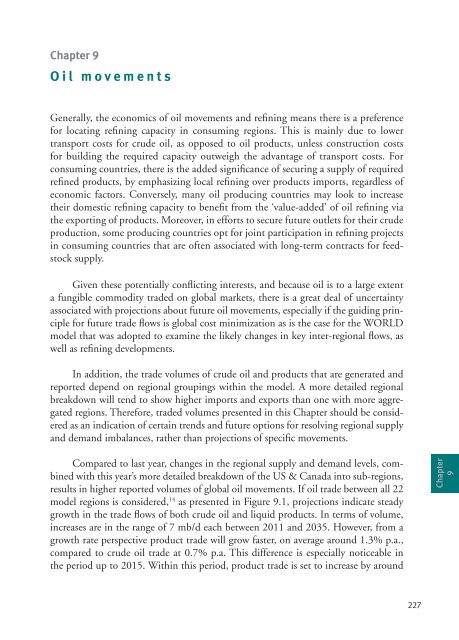World Oil Outlook - Opec
World Oil Outlook - Opec
World Oil Outlook - Opec
- TAGS
- world
- outlook
- opec
- www.opec.org
You also want an ePaper? Increase the reach of your titles
YUMPU automatically turns print PDFs into web optimized ePapers that Google loves.
Chapter 9<br />
<strong>Oil</strong> movements<br />
Generally, the economics of oil movements and refining means there is a preference<br />
for locating refining capacity in consuming regions. This is mainly due to lower<br />
transport costs for crude oil, as opposed to oil products, unless construction costs<br />
for building the required capacity outweigh the advantage of transport costs. For<br />
consuming countries, there is the added significance of securing a supply of required<br />
refined products, by emphasizing local refining over products imports, regardless of<br />
economic factors. Conversely, many oil producing countries may look to increase<br />
their domestic refining capacity to benefit from the ‘value-added’ of oil refining via<br />
the exporting of products. Moreover, in efforts to secure future outlets for their crude<br />
production, some producing countries opt for joint participation in refining projects<br />
in consuming countries that are often associated with long-term contracts for feedstock<br />
supply.<br />
Given these potentially conflicting interests, and because oil is to a large extent<br />
a fungible commodity traded on global markets, there is a great deal of uncertainty<br />
associated with projections about future oil movements, especially if the guiding principle<br />
for future trade flows is global cost minimization as is the case for the WORLD<br />
model that was adopted to examine the likely changes in key inter-regional flows, as<br />
well as refining developments.<br />
In addition, the trade volumes of crude oil and products that are generated and<br />
reported depend on regional groupings within the model. A more detailed regional<br />
breakdown will tend to show higher imports and exports than one with more aggregated<br />
regions. Therefore, traded volumes presented in this Chapter should be considered<br />
as an indication of certain trends and future options for resolving regional supply<br />
and demand imbalances, rather than projections of specific movements.<br />
Compared to last year, changes in the regional supply and demand levels, combined<br />
with this year’s more detailed breakdown of the US & Canada into sub-regions,<br />
results in higher reported volumes of global oil movements. If oil trade between all 22<br />
model regions is considered, 14 as presented in Figure 9.1, projections indicate steady<br />
growth in the trade flows of both crude oil and liquid products. In terms of volume,<br />
increases are in the range of 7 mb/d each between 2011 and 2035. However, from a<br />
growth rate perspective product trade will grow faster, on average around 1.3% p.a.,<br />
compared to crude oil trade at 0.7% p.a. This difference is especially noticeable in<br />
the period up to 2015. Within this period, product trade is set to increase by around<br />
227<br />
Chapter<br />
9
















